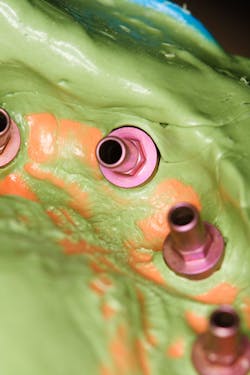5 things you need to know prior to offering dental implant service
Editor's note: Originally published March 7, 2016. Formatting updated January 20, 2024.
Dental implants are lucrative. They’re a high ticket item that can pull in around $2,000 in the Midwest and $5,000 on the east and west coasts per implant body placement alone. But for every reward there is usually a risk. Large income often translates to large costs. The financial gains you may pocket can vary depending on the location and clientele of your practice. Here are five things you need to consider before setting up a dental implant service for your practice.
No. 1: Implant system
The main fixed costs of implant therapy come from the implant system and components. When choosing an implant system, it’s wise to choose the same one that the specialist you work with regularly places. If you’re not comfortable with the way that system restores, choose one that your specialist has in his or her office or has placed before. The reason behind this will be explained later.
Depending on the implant system, the cost can vary tremendously. The most consistent and recurring cost to implant therapy will be the implant body itself. Some systems can run as low as $250 and some as high as $500 to $600 for “active” surfaces. You can find implants for less than this, but remember the adage, “you get what you pay for.”
Most implant companies run specials or “deals” if you purchase several implants at a time. This is actually a good investment. You might think that you aren't planning on placing 20 or 30 implants right away, so why would you need that many? Well, you need to have a variety of sizes in your wheelhouse for treatment planning purposes. One implant size does not fit all. You’ll find that you’ll have a “go to” size as time goes on, but until your learning curve is lessened, it’s wise to have a variety of implants on hand.
Another one-time fixed cost is the implant drill motor. These units can be purchased from your implant company, and a reasonable purchase price is anywhere from $1,500 to $5,000. Some implant companies may “give” you this motor if you purchase a certain number of implants at full price.
Next is the surgical kit. This will include all of the implant drills, depth gauges, sizing guides, and things that are proprietary to each implant system. You may be able to get it for “free” if you purchase a certain number of implants at full price. Otherwise it can cost $5,000 to $10,000.
The last one (optional) is imaging. This is one of the biggest costs to an implant practice. Cone Beam Computerized Tomography (CBCT) is the standard of care in implant dentistry. While you could source it out to someone, I recommend you get it if your budget allows. It is a billable procedure and will be very beneficial in many ways. For starters, it will be a huge marketing point for your practice. You will be able to say that you have the most up-to-date technology, offering same-day implant services, and it will keep all billable procedures within your office. The price tag starts at $100,000.
When you go down the road of purchasing your own CBCT, you may want to look into true computer-guided surgeries. There is little to no setup cost to these procedures. They are computer-guided stents that match your CBCT radiograph to an impression of the patient's mouth, which allows for a more exact fit of size and depth of implant. They cost around $500 to $1,500 per arch. Keep in mind that you will need additional training to learn to use these.
No. 2: Professional training
You may have already been trained in dental school in implant placement. While this is great, I would encourage you to attend one of the large implant symposiums held once a year. The cost is usually pretty inexpensive, meaning you can attend for less than $1,000. By attending this, most of your continuing education will be completed for your two-year licensure cycle.
If your budget is tight, consider opting for courses that offer an inexpensive fee, albeit you would be putting implants into a synthetic bone or bovine bone. While that may provide you with some training, your patients do not have bovine or synthetic bone composition in their mouths. This is a “you get what you pay for” kind of deal. On the flip side, there are courses that start at about $5,000 and up.
No. 3: Hidden costs
Now let’s dive into some of the hidden costs that are also fixed. First is drill cost. You will have a complete set up in your brand new surgical kit; however, these drills are only good for about five to 10 uses depending on bone type. As a general rule, you can figure about $100 of drill cost to be set aside per implant case.
Next is irrigation. You need to pay for irrigation bags and lines for your implant motor. These can be bought in bulk, and per implant case should not run more than about $20 to $30. This is the standard of care in implant dentistry now. It used to be that dentists could hand irrigate. This is no longer the case. Do not try to do this, especially as an inexperienced surgeon. This can lead to excessive implant failures.
No. 4: Staffing
The biggest overhead to any practice is staff. You need to ask yourself how adding implants to your practice is going to affect it. Let’s assume you’re adequately trained in basic dental surgical procedures and your staff is adequately trained to assist you. A well-trained surgical assistant will be able to handle almost anything in implant dentistry. The biggest shift in your overhead will be the amount of chair time spent while you overcome your learning curve. Only you can predict how long and how much this will cost.
No. 5: Don’t break the status quo
Next is something that many dentists fail to consider—maintaining a degree of status quo in your professional networking relationships. You were once the restoring dentist and you referred to a specialist. You need to maintain this relationship. Read that again. Not every case is a “slam dunk.” The specialist that you have had a relationship with for years will need to bail you out in the future. It is not a question of if, but rather when. You should continue to refer a few “easy” cases to him or her every once in a while. Specialists have needs for general dentists and need to refer things out periodically. You want to be there in their time of need.
This is especially true in the case of teaming up with a periodontist or oral surgeon for a case. In the early days of your dental implant journey, you will likely not be doing a ton of bone grafting or guided tissue regeneration. If you have to refer out the building of the bone for implant site harvesting, it can be helpful to your relationship with specialists if you also have them place the implant. Not only will they appreciate the referral, but this can be advantageous to patients as oftentimes they can benefit from a sinus lift or a ridge splitting procedure that may allow them to avoid a second surgery for the implant placement.
As you can see, the costs of starting a dental implant practice are not finite and can be rather abstract. These costs can come in ways that can permanently affect your practice. You need to make calculated decisions at every step. Your dental implant rep can help, but let me give you my best advice—ask colleagues or hire a consultant. The first may cost you a cup of coffee while you ask as many questions as you can. The latter, while it may cost an upfront fee, will save you from making poor decisions, and will thereby save you a lot of money.
Ahmed Ezzeldin, DDS, is a practicing dentist in Gainesville, Virginia. A native of Northern Virginia, Dr. Ezzeldin enjoys staying active by running, biking, reading social psychology books, and listening to podcasts. When he is not doing dentistry, he spends time with his wife and daughter. He can be reached at [email protected].
Justin Clemens, DDS, is a retired periodontist and implant specialist who now specializes in dental practice consulting and growth. His area of expertise is incorporating surgical dental implant treatment into the general practice.








